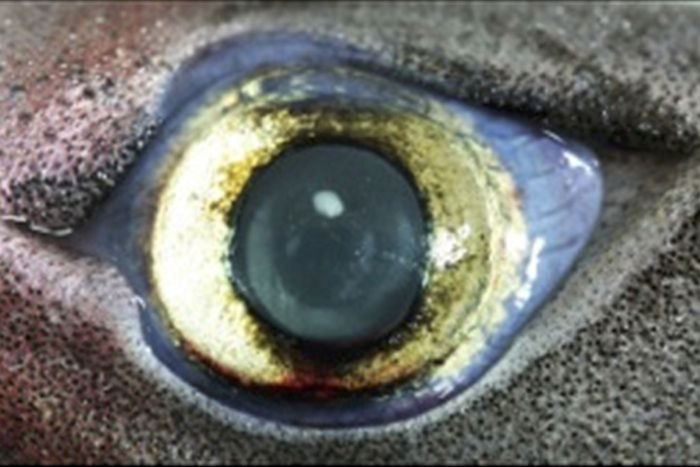
Glow-in-the-Dark Sharks Have Super-Sensitive Eyes
News to Know
Abstract
In the twilight zone, bright sharks know how to hide in the light.
News Sources
Under the sea it can get pretty dark, and even the “twilight” zone offers challenges to animals that must evade predators and eat to survive in those murky waters. Some deep-sea sharks are specially equipped to see in the dark while they hide in the dim bluish light of this mesopelagic zone 650 to 3,300 feet below the surface.

The eye of each species of bioluminescent shark is designed to capture as much light as possible. On the top of this eye there is a newly discovered translucent window; it may admit light from above so that the shark can match the light glowing from its underside to the light from above as camouflage. Or perhaps it just helps the shark see its next meal swimming overhead. On the lower portion of the iris in this photo is a notch that admits extra light to the retina and may enable partially binocular vision. The light-sensitive cells on the bioluminescent shark’s retina are long, thin, and very dense, capturing a lot of light and producing smooth continual images of fast-moving objects. The retina also contains super-light-sensitive regions in specific patterns. In one species, these patterns of increased resolution seem designed to improve recognition of the bioluminescent patterns produced by other sharks of the same species. Image by FNRS/UCL: Dr. J. Mallefet, via ABC News.
Biodiverse Bioluminescence
“These amazing little animals aren't well understood, so by studying their eyes we can gain useful insights into how these sharks make a living,” says Julian Partridge, coauthor of “Photon Hunting in the Twilight Zone: Visual Features of Mesopelagic Bioluminescent Sharks,” published in PLoS ONE.
Belgian biologist and lead author Julien Claes and colleagues have learned that twelve percent of shark species—about fifty in all—are able to produce their own light. They studied five bioluminescent shark-y denizens of the deep: four lantern shark species (Etmopterus lucifer, E. splendidus, E. spinax, and Trigonognathus kabeyai) and one dalatiid kitefin shark (Squaliolus aliae). They compared them with each other and with non-bioluminescent sharks. The sharks they studied included some that swim freely, some that spend most of their time at the bottom, and some that hang out near the bottom in the day but swim freely at night. The assortment included hunters and scavengers. They found each had eyes individually tailored to gather as much visual information as possible.
Some sharks generate light that matches the varying intensity of ambient sunlight above them. They thus camouflage themselves by blending their silhouettes with light from above. This ability may help them hide from enemies and sneak down upon their prey. While we tend to focus on sharks’ predatory nature, some are themselves quite vulnerable, such as one lantern shark species only 50 centimeters long, just a good size bite for a bigger fish. But camouflage must not be the only reason sharks glow-in-the-dark, as some have “light-saber” spines likely to make them appear scary rather than invisible. Enhanced light sensitivity tailored to detect the flashy pattern of its own species suggests that at least one of these animals is equipped with light-recognition software.
Directional Vision Sensitivity
Shiny shark eyes are more light-sensitive eyes than the eyes of sharks that do not glow. They must be able to capture detailed information quickly, as they may glow only briefly. “They can see fairly fine detail for a fish, although it's not as good as humans,” explains Partridge. “We also found differences in the density patterns of the rods and ganglion cells, depending on whether these sharks lived in mid water, or near the sea floor.”
Rods are the light-sensitive cells on the retina, the “screen” on which light entering the eye focuses to form an image. Ganglion cells are the nerve cells on the retina that transmit visual information to the brain. The more light-sensitive rods packed into an area on the retina, the more light-sensitive that area is.
Bioluminescent sharks maximize light sensitivity with an overall greater retinal rod density than dark sharks. Additionally, deep-sea bottom-feeders have super-sensitive regions positioned on the retina where they will offer the best view of the seafloor. By contrast, there is no such enhanced directional sensitivity in sharks that swim in open water. All their eyes detect light very well, and each is ideally equipped to best see what it most needs to see.
“We found things which hadn't been seen before in sharks, such as a layer of tissue behind the retina to reflect and increase the light available to photoreceptors,” explains Partridge. The preponderance of long thin rods enables them to see smooth real-time images of fast-moving objects rather than a series of quickly changing snapshots. Other modifications include a notch-like gap between the lens and iris that allows more light to reach the retina at strategic locations.
Super-sensitive retinal regions oriented for directional enhancement or pattern recognition consist of high density patches and strips of photosensitive cells. Like some other predatory fish, these sharks have facial furrows and pupillary notches arranged to allow light from the opposite side of the fish’s body to reach the retina, making partially binocular vision possible. Each bioluminescent shark species seems to have individualized traits tailored for its specific habitat and dietary habits.
Matched Lights
“If you're an animal in the sea where there's still some down-welling light, you can look upwards for silhouettes that might then become your lunch,” says Partridge, explaining the importance of matching the color, intensity, and distribution of the down-welling light. “So there's a lot of selective pressure for animals to disguise their silhouette because there's nothing to hide behind in the deep sea. One way to deal with that is by disguising their shape by putting lights on their bellies.”
If the same evolutionary authors speculated about the origin of two comparable non-biological systems, they would likely conclude they’d seen a “not unexpected great design”!
How do sharks detect the changing light intensity above and modify the light they produce? “That's always intriguing,” says Partridge, “how an animal monitors both the down-welling light and its own bioluminescence to match the two. This teaches us new things about the deep sea which is the biggest living space on the planet, and yet it's also the environment we know least about.”
Researchers are not sure how the bioluminescent sharks pull this off, but they suspect some of them use a “peculiar translucent area”1 on the top of the eye as a window to admit light from above. One species studied lacks this translucent patch, but it does have a groove positioned to allow light from above the shark to reach its retina. Light is evidently measured and matched by the light-producing cells on the body. Just how this is done is still unknown, but the mechanism may resemble that used by bioluminescent bony fish and involve the signaling chemical melatonin in the pineal gland.
Coevolution?
How did sharks develop a variety of ways to pair light production and heightened visual sensitivity? How did they develop ways to match the intensity and color of ambient light? How did one species even develop retinal sensitivity patterns matching the lights adorning its fellow sharks?
Evolutionary biologists believe sharks’ bioluminescent patterns and visual modifications co-evolved. Etmopterids, the category into which four of these species fall, have distinctive patterns of light-producing patches that researchers suspect help them communicate with others of their own species. They write. “It is therefore not unexpected that the visual systems of these sharks have co-evolved to optimize detection of these bioluminescent signals.”2
Even in this small sample of closely related shark species, there is great biodiversity. Yet all are sharks. No evolution of new kinds of animals is in view, just variations based on the genetic information in sharks. It will be interesting in the future to perhaps learn if the genes coding for variations in visual sensitivity are in any way linked to those coding for bioluminescence patterns. But in any case, natural selection and other ordinary genetic mechanisms could produce populations of species and varieties with suitably paired complementary traits. Coexistence of complementary traits does not imply their coevolution, certainly no evolution in the molecules-to man sense!
“Co-evolution” is an unfortunate choice of words to describe the co-selection of variations that are already available in the genome of the shark. Nothing in the study reports any effort to even remotely support the authors’ leap to their conclusion that the visual and bioluminescent systems in sharks “coevolved.” They simply write that such coevolution is “not unexpected.” Well, thanks to their evolutionary bias such a conclusion might not be “unexpected,” but nothing they reported in this fascinating study demonstrated a shred of support for their “coevolution” conclusion. It is an interpretation based on nothing more that the evolutionary belief that if two biological systems work well together they must have evolved together. If the same evolutionary authors speculated about the origin of two comparable non-biological systems, they would likely conclude they’d seen a “not unexpected great design”!
Evolutionists invoke “coevolution” as the source of complementary traits, but they still cannot explain how any of these traits came to be in the first place. No molecules-to-man evolution is needed for this to occur, only ordinary processes of variation and selection within created kinds.Evolutionists have never shown how molecules-to-man evolution can create new information such as would be needed to produce even a dark shark from a simpler animal, much less a glowing one.
God made all kinds of fish (Genesis 1:20–23) on Day 5 of Creation Week about 6,000 years ago. We can’t be dogmatic about how many kinds of sharks He made or what they were like. Did all glow? Did all have super-sensitive eyes? Since sharks today are carnivorous and the original animals God created were not, we can safely say that variations in sharks have produced the many varieties that differ in diet from the original kinds of sharks. Carnivory and the prevalence of attack and defense structures in nature are stark reminders of sin’s curse in this world.
Further Reading
- Hot-blooded Sharks
- Flies with Lice
- Toward an Accurate Model of Variation in DNA
- How Could Fish Survive the Genesis Flood?
- Squid’s Secret Countermeasure
- Thorns and Thistles
- Snails Go On the Offensive
- The Splendor of Thorns
For More Information: Get Answers
Remember, if you see a news story that might merit some attention, let us know about it! (Note: if the story originates from the Associated Press, FOX News, MSNBC, the New York Times, or another major national media outlet, we will most likely have already heard about it.) And thanks to all of our readers who have submitted great news tips to us. If you didn’t catch all the latest News to Know, why not take a look to see what you’ve missed?
(Please note that links will take you directly to the source. Answers in Genesis is not responsible for content on the websites to which we refer. For more information, please see our Privacy Policy.)
Footnotes
- J. Claes et al., “Photon Hunting in the Twilight Zone: Visual Features of Mesopelagic Bioluminescent Sharks,” PLoS ONE 9, no. 8: e104213, doi:10.1371/journal.pone.0104213.
- Ibid.
Recommended Resources

Answers in Genesis is an apologetics ministry, dedicated to helping Christians defend their faith and proclaim the good news of Jesus Christ.
- Customer Service 800.778.3390
- © 2024 Answers in Genesis



